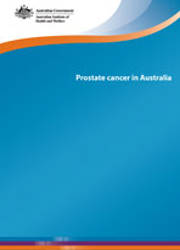Summary
The effect of prostate cancer is wide reaching—affecting males diagnosed with the condition, their families and communities.
Prostate cancer in Australia is the first comprehensive national report on prostate cancer in Australia. It provides an overview of the condition, its risk factors, diagnosis and management, and key summary measures including incidence, mortality and survival. Comparisons over time and by age, selected population groups and international region are also presented.
Prostate cancer is the most commonly diagnosed cancer in Australia
There were 21,808 new cases of prostate cancer diagnosed in 2009. The age-standardised incidence of prostate cancer has increased over time, from 79 new cases per 100,000 males in 1982 to 194 per 100,000 in 2009. This increase is expected to continue, reaching 25,000 new cases per year in 2020, due to increases in the number of men presenting for testing, changes in diagnostic practices and the ageing of the population.
Mortality rates are decreasing
There were 3,294 deaths from prostate cancer recorded in 2011, making it the fourth leading cause of death among Australian males, behind coronary heart diseases, lung cancer and cerebrovascular diseases. The age-standardised mortality rate has decreased over time, from 34 deaths per 100,000 males in 1982 to 31 deaths per 100,000 in 2011. This decline is expected to continue, to 26 deaths per 100,000 males in 2020.
Survival is high and improving
In 2006–2010, around 9 in 10 (92%) males diagnosed with prostate cancer survived 5 years from diagnosis. This is higher than for all cancers among males (65%), as well as other leading cancers among males, including melanoma of the skin (89%) and lung cancer (13%). Prostate cancer 5-year survival is high and has improved from 59% in 1986 to 90% in 2007.
Expenditure on prostate cancer has increased
Health-care expenditure on prostate cancer was estimated to be $349 million in 2008–09, an increase of 23% on expenditure in 2004–05. This increase in expenditure on prostate cancer corresponds with the increase in new cases of prostate cancer identified between 2002 and 2008.
There are differences between some population groups
Aboriginal and Torres Strait Islander males were less likely to be diagnosed with prostate cancer, but similarly likely to die from prostate cancer, compared with non-Indigenous males. Males living in Inner regional areas were more likely to be diagnosed with prostate cancer (186 new cases per 100,000 males) and those living in Remote/Very remote areas were less likely (150 per 100,000), compared with males living in all other regions.
The observed differences between these population groups could be due to variations in: rates of presenting for testing, population risk profiles and population age structures.
Preliminary material: Acknowledgments; Abbreviations; Symbols
1 Introduction
- Overview
- The prostate
- Prostate cancer
- Characteristics
- Risk factors
2 Detection, diagnosis and management
- Key findings
- Detection and diagnosis
- Prostate-specific antigen testing
- Digital rectal examination
- Biopsy of the prostate
- Management and treatment
- No initial treatment, active surveillance
- Active treatment
- Palliative care
3 Incidence
- Key findings
- Overview
- Age comparison
- Time trend
- Projected incidence to 2020
4 Mortality
- Key findings
- Overview
- Age comparison
- Time trend
- The influence of incidence on mortality
- Projected mortality to 2020
5 Survival
- Key findings
- Overview
- Age comparison
- Time trend
6 Expenditure on prostate cancer
- Key findings
- Overview
- Age comparison
- Time trend
7 Population groups
- Key findings
- Overview
- State and territory
- Aboriginal and Torres Strait Islander status
- Remoteness area
- Socioeconomic disadvantage
- Country of birth
8 International comparisons
- Key findings
- Overview
- Incidence
- Mortality
- Mortality-to-incidence ratio
Appendix 1 Technical information
End matter: References; List of tables; List of figures; List of boxes; Related publications



